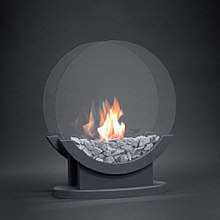Fire glass
Fire glass (fire pit glass, fire rocks, fireplace glass, flammable glass, fire beads, lava glass[1]) is simply pieces of tempered glass with no special manufacturing process. It may be specially shaped and coloured, and it is not coated with flammable coatings, but otherwise, fire glass is no different than standard tempered glass windows.
Purpose

Fire glass does not burn; it is decorative.[2] It is heaped around jets of burning gas, or around liquid ethanol,[3] in order to hide the jets and reflect the flames.[2] It is an alternative to ceramic and stone decorative elements, such as ceramic logs and pumice ("lava rock").[2][4]
Manufacturing processes
Fire glass is sold in a wide range of colours. It may be made in different shapes, such as beads, diamonds, cubes or rounded pebbles. The size ranges from 1/4 inch, 1/2 inch, 1 inch to 5/8 inch; it comes in various different colors, and may include reflective coatings.[2][5]
The first fire glass to hit the U.S. market, around 2006, was shattered in form. This is the most popular fire glass and is typically reflective glass on one side and colored on the other. The reflective coating gives a shimmering effect when in use. The shattered or broken tempered glass is the most popular form of fire glass used by consumers.
Broken standard sheets of tempered glass are typically sifted to remove any sandy, small, or very sharp pieces of glass, while the rest may optionally be lightly tumbled to remove the sharp edges. Local outdoor living companies or online retailers will often obtain broken tempered glass from local glass companies, then shatter, sift, clean and package the glass to sell to consumers. U.S. companies will also import fire glass from China by the container, as it is not made in U.S.A. in bulk.
Health hazards
The glass itself is unchanged by the fire, so it emits nothing. Fire glass accumulates dust and black soot produced by the burning hydrocarbons. Fire glass is glass, and can thus be cleaned with vinegar & water. Lighting the flames while there is any water on the glass can lead to uneven heating and cause the fire glass to shatter explosively. Gloves should be worn when handling glass, and any broken pieces sifted out and recycled.[6][7]
Other health and effects depend on the fuel. Propane, butane, and methane are all flammable gasses (natural gas is mostly methane, liquefied petroleum gas mostly propane). If they are allowed to accumulate unburned, gasses can cause suffocation by displacing air,[10] and gas explosions. Ethanol (a liquid) and gas fires can both cause severe burns.[11]
Burning hydrocarbons causes indoor air pollution. Emissions include airborne particulate matter (such as black carbon) and nitrogen oxides. These harm health: they weaken the immune system, and increase infections, blood pressure, cardiovascular deaths, and insulin resistance. Some forms of fuel are more harmful than others.[12]
Burning hydrocarbon fuels incompletely can produce carbon monoxide, which is highly poisonous and can cause death and long-term neurological problems.[13]
Environmental effects
Burning any hydrocarbon fuel releases carbon dioxide. Other emissions, such as nitrogen oxides and sulfur oxides, are also harmful to the environment.
See also
References
- "Fire Glass, Rocks & Beads for Fire Pits". Starfire Direct.
- "The Wonderful, Sparkling, Vibrant World of Fire Glass!". Starfire Direct. Retrieved 2019-10-11.
- Khai (2011-03-21). "Adding Fuel To The Fire Pit – Part 1: NG vs LPG". paloform.com.
- Littman, Margaret (22 September 2011). "Light your fire the eco-friendly way". Retrieved 18 April 2016.
- "What is Fire Glass". www.duraflamefireglass.com. Retrieved 2019-10-11.
- "How To Clean Fire Glass". Starfire Direct. Retrieved 2019-10-11.
- "How To Clean Fire Glass". The Magic of Fire.
- Fukunaga, T; Yamamoto, H; Tanegashima, A; Yamamoto, Y; Nishi, K (25 October 1996). "Liquefied petroleum gas (LPG) poisoning: report of two cases and review of the literature". Forensic Science International. 82 (3): 193–200. doi:10.1016/s0379-0738(96)01995-0. PMID 8948127.
- Novosel, I; Kovačić, Z; Gusić, S; Batelja, L; Nestić, M; Seiwerth, S; Skavić, J (April 2011). "Immunohistochemical detection of early myocardial damage in two sudden deaths due to intentional butane inhalation. Two case reports with review of literature". Journal of Forensic and Legal Medicine. 18 (3): 125–31. doi:10.1016/j.jflm.2010.12.003. PMID 21420651.
- Suffocations may be caused by propane,[8] butane[9]
- Kraemer, R; Knobloch, K; Lorenzen, J; Breuing, KH; Koennecker, S; Rennekampff, HO; Vogt, PM (2011). "Severe burn injuries caused by bioethanol-design fireplaces-an overview on recreational fire threats". Journal of Burn Care & Research. 32 (2): 173–7. doi:10.1097/BCR.0b013e31820aade7. PMID 21233730.
- Apte, K; Salvi, S (2016). "Household air pollution and its effects on health". F1000Research. 5: 2593. doi:10.12688/f1000research.7552.1. PMC 5089137. PMID 27853506.
Burning of natural gas not only produces a variety of gases such as sulfur oxides, mercury compounds, and particulate matter but also leads to the production of nitrogen oxides, primarily nitrogen dioxide...The burning of biomass fuel or any other fossil fuel increases the concentration of black carbon in the air...[rest of material in linked fulltext]
- Casillas, S; Galindo, A; Camarillo-Reyes, LA; Varon, J; Surani, SR (15 October 2019). "Effectiveness of Hyperbaric Oxygenation Versus Normobaric Oxygenation Therapy in Carbon Monoxide Poisoning: A Systematic Review". Cureus. 11 (10): e5916. doi:10.7759/cureus.5916. PMC 6855999. PMID 31788375.